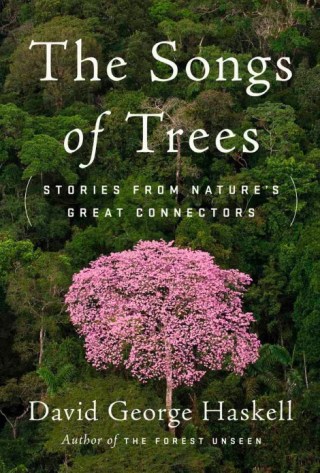Some inspiring thoughts from Brain Pickings about the wonder of trees. As one of the most awe-inspiring phenomena of nature, it’s small wonder that they feature so prominently at Shinto shrines. The sacred forests there speak to our hearts and leave the visitor refreshed and renewed by their soaring vigour.
************
“Trees speak to the mind, and tell us many things, and teach us many good lessons,” an English gardener wrote in the seventeenth century. “When we have learned how to listen to trees,” Hermann Hesse rhapsodized two centuries later in his lyrical love letter to our arboreal companions, “then the brevity and the quickness and the childlike hastiness of our thoughts achieve an incomparable joy.”
For biologist David George Haskell, the notion of listening to trees is neither metaphysical abstraction nor mere metaphor.
In The Songs of Trees: Stories from Nature’s Great Connectors, Haskell proves himself to be the rare kind of scientist Rachel Carson was when long ago she pioneered a new cultural aesthetic of poetic prose about science, governed by her conviction that “there can be no separate literature of science”because “the aim of science is to discover and illuminate truth,” which is also the aim of literature.
It is in such lyrical prose and with an almost spiritual reverence for trees that Haskell illuminates his subject — the masterful, magical way in which nature weaves the warp thread of individual organisms and the weft thread of relationships into the fabric of life.

Illustration by Arthur Rackham for a rare 1917 edition of the Brothers Grimm fairy tales.
Haskell writes:
For the Homeric Greeks, kleos, fame, was made of song. Vibrations in air contained the measure and memory of a person’s life. To listen was therefore to learn what endures.
I turned my ear to trees, seeking ecological kleos. I found no heroes, no individuals around whom history pivots. Instead, living memories of trees, manifest in their songs, tell of life’s community, a net of relations. We humans belong within this conversation, as blood kin and incarnate members. To listen is therefore to hear our voices and those of our family.

Photographs from Cedric Pollet’s project Bark: An Intimate Look at the World’s Trees.
Haskell visits a dozen gloriously different trees from around the world — from the hazel of Scotland to the redwoods of Colorado to the white pine of Japan’s Miyajima Island — to wrest from them wisdom on what he calls “ecological aesthetics,” a view of beauty not as an individual property but as a relational feature of the web of life, belonging to us as we to it. (Little wonder that trees are our mightiest metaphor for the cycle of life.) From this recognition of delicate mutuality arises a larger belonging, which cannot but inspire a profound sense of ecological responsibility.
Haskell writes:
We’re all — trees, humans, insects, birds, bacteria — pluralities. Life is embodied network. These living networks are not places of omnibenevolent Oneness. Instead, they are where ecological and evolutionary tensions between cooperation and conflict are negotiated and resolved. These struggles often result not in the evolution of stronger, more disconnected selves but in the dissolution of the self into relationship.
Because life is network, there is no “nature” or “environment,” separate and apart from humans. We are part of the community of life, composed of relationships with “others,” so the human/nature duality that lives near the heart of many philosophies is, from a biological perspective, illusory. We are not, in the words of the folk hymn, wayfaring strangers traveling through this world. Nor are we the estranged creatures of Wordsworth’s lyrical ballads, fallen out of Nature into a “stagnant pool” of artifice where we misshape “the beauteous forms of things.” Our bodies and minds, our “Science and Art,” are as natural and wild as they ever were.
We cannot step outside life’s songs. This music made us; it is our nature.
Our ethic must therefore be one of belonging, an imperative made all the more urgent by the many ways that human actions are fraying, rewiring, and severing biological networks worldwide. To listen to trees, nature’s great connectors, is therefore to learn how to inhabit the relationships that give life its source, substance, and beauty.

Art by Cécile Gambini from Strange Trees by Bernadette Pourquié, an illustrated atlas of the world’s arboreal wonders.
In the ceibo Haskell finds a living testament to the nonexistence of the self to which we humans so habitually cling. A century after young Jorge Luis Borges contemplated how the self dissolves in time and relationship, Haskell writes:
This dissolution of individuality into relationship is how the ceibo and all its community survive the rigors of the forest. Where the art of war is so supremely well developed, survival paradoxically involves surrender, giving up the self in a union with allies. … The forest is not a collection of entities… it is a place entirely made from strands of relationship.

Photo John Dougill
The Songs of Trees is a resplendent read in its entirety, kindred to both Walt Whitman’s exultation of trees and bryologist Robin Wall Kimmerer’s poetic celebration of moss. Complement it with the fascinating science of what trees feel and how they communicate.

Leave a Reply